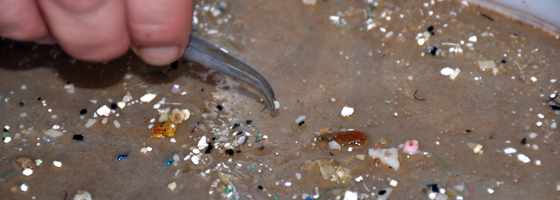Plastic debris turning ocean deserts to insect egg havens

An oceanic desert in the Pacific now may be a hot spot for insect procreation thanks to floating plastic debris, according to research from the University of California San Diego.
Plastic is deposited in the ocean from pollution and runoff. It decomposes into finger-nail-sized particles and aggregates in the ocean gyres, where currents meet and create a huge area of still water.
Floating bits of plastic in the famed “Great Pacific Garbage Patch” of the North Pacific Gyre are an ideal surface for a species of oceangoing water striders to lay eggs, said Miriam Goldstein, a PhD student of biological oceanography at UC San Diego’s Scripps Institute of Oceanography.
The insect is related to water striders found in ponds and creeks across the country. They lay eggs on hard surfaces floating on the water. “Now that there’s all of this plastic, there’s hard surfaces everywhere,” Goldstein said.
Water strider eggs increased thanks to newly available plastic egg laying locations, Goldstein’s research found. Last April, researchers with the Instituto Oceanografico in Brazil observed the same trend with another strain of water strider in the South Atlantic.
Marine animals feed on sea striders and their eggs, so a rise in the insect’s population could have an impact on the ocean foodweb. The connection between plastic and marine life could be especially important because the amount of plastic in the North Pacific gyre has increased greatly in the last few decades.
Goldstein said plastic particles in the gyre increased 100-fold compared to data collected from the 1970s through the 1980s. Her research found an average of 0.425 pieces of plastic per square meter in the North Pacific Gyre. The gyre spans an area three times the size of the United States, so the plastic particles add up quickly.
Goldstein collected samples by dragging a meter-wide fine mesh net over the water’s surface, then scanned and counted the plastic particles using a ZooSCAN plankton scanner.
Despite large increases in plastic aggregating in the North Pacific, plastic collecting in the North Atlantic hasn’t increased for 25 years, said Kara Lavender, chief scientist of oceanography faculty at the Sea Education Association.
SEA, an organization that hosts college students aboard research vessels, has collected data on plastic in the Atlantic since the 1970s. Lavender said they found people are using more plastic, but plastic debris in the North Atlantic hasn’t increased. “Instead, we found a flat trend,” she said.
Lavender said there could be many reasons for this. Their sampling only skims the water’s surface, plastic particles could break down so small that the net fails to catch them, and sea creatures could grow on the plastic, forcing it to sink below the ocean’s surface.
Organisms also eat plastic particles. Scripps researchers estimated that nine percent of fish they collected in the North Pacific ingested plastic.
It’s also possible there is not plastic entering their area of study, or that it’s too widely dispersed to increase statistical data.
But one thing is certain: Plastic is not leaving the ocean anytime soon. Even if there were enough money and enough people behind a plastic removal effort they still would have little chance of putting a dent in the continual flow of plastic into the ocean, Goldstein said.
She said a cleanup could even cause more change to the ocean. Nets used to collect plastic would also collect sea creatures that live on the surface of the water making oceanic deserts of the world even more deserted.
Top image: Plastic pieces, typically millimeters in size, are hand-picked and enumerated from a sample collected with a surface plankton net. (SEA/Marilou Maglione)





0 comments